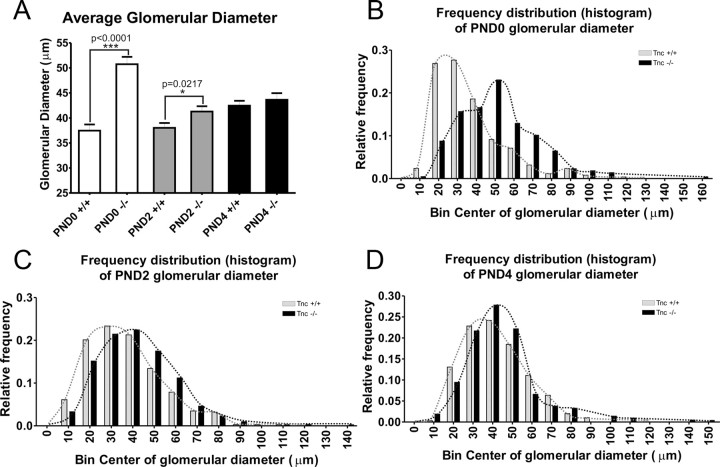Figure 6.
Quantification of glomerular development in Tnc−/− mice. A, Glomerular diameter was measured (parallel to the ONL) using MetaMorph software on the medial surface of OB of Tnc+/+ and Tnc−/− mice at PND0, PND2, and PND4. Glomeruli were identified as being both NCAM (red) and VGlut2 (green) positive and glomerular boundaries confirmed with DAPI staining (Fig. 5). At PND0, glomeruli were observed to have a significantly larger diameter (50.75 ± 1.46 μm; n = 217) in null mice compared with wild-type controls (37.47 ± 1.23 μm; n = 253) with p < 0.0001 using an unpaired Student's t test. At PND2, glomeruli have coalesced in the null mice to 41.28 ± 1.05 μm (n = 303), which is still significantly larger compared with wild-type glomeruli, which have a relatively unchanged diameter of 38.03 ± 0.95 μm (n = 343), with p = 0.0217 using an unpaired Student's t test. By PND4, both Tnc+/+ and Tnc−/− glomeruli have increased in size from PND2 and are not significantly different from each other [value of p = 0.4709; wild type, 42.44 ± 0.99 μm (n = 298); null, 43.62 ± 1.35 μm (n = 212)]. Error bars indicate ± SEM. *P < 0.05, ***P < 0.0001. B, Histogram of glomerular diameter at PND0. In Tnc+/+ mice, the peak of the curve was located between bins 20 and 30 μm, with 54.6% of glomeruli residing in these bins. In contrast, in Tnc−/− mice, the peak was located at 50 μm, with 23% glomeruli residing in this bin. Thus, the frequency distribution was clearly shifted to the left, indicating larger glomerular diameter size. C, At PND2, the Tnc−/− frequency distribution curve had shifted more to the right, compared with PND0, and was much closer to the Tnc+/+ distribution curve. The peak of the Tnc−/− curve occurs at 40 μm (bin contains 22.4% of glomeruli), whereas the peak of the Tnc+/+ curve is around 30 μm (bin contains 23.3% of glomeruli). D, By PND4, both Tnc−/− and Tnc+/+ curves have peaks that occur around 40 μm (bins contain 27.8 and 24.2% glomeruli, respectively).

